#1870s evening dresses
Photo

Alfred Stevens, After the Ball. 1874
This painting, also known as Confidence, is one of several by Stevens to treat the theme of consolation. As in his other works from the 1870s, here the anecdotal content of a letter containing distressing news asserts itself in a glimpse of the life of fashionable Parisian women in their elegant interiors. Stevens's subject matter and his meticulous attention to contemporary dress and decor elicited analogies to seventeenth-century Dutch and Flemish art; in fact, one critic called him the Gerard ter Borch of France.
The Metropolitan Museum of Art
#alfred stevens#1874#painting#after the ball#confidence#consolation#parisian women#paris#elegant interiors#art#fine art#alfred Émile léopold stevens#elegant modern women#elegance#alluring women#alluring#1870s fashion#1870s evening dresses#full-skirted#narrow silhouette#Tea gowns
217 notes
·
View notes
Text
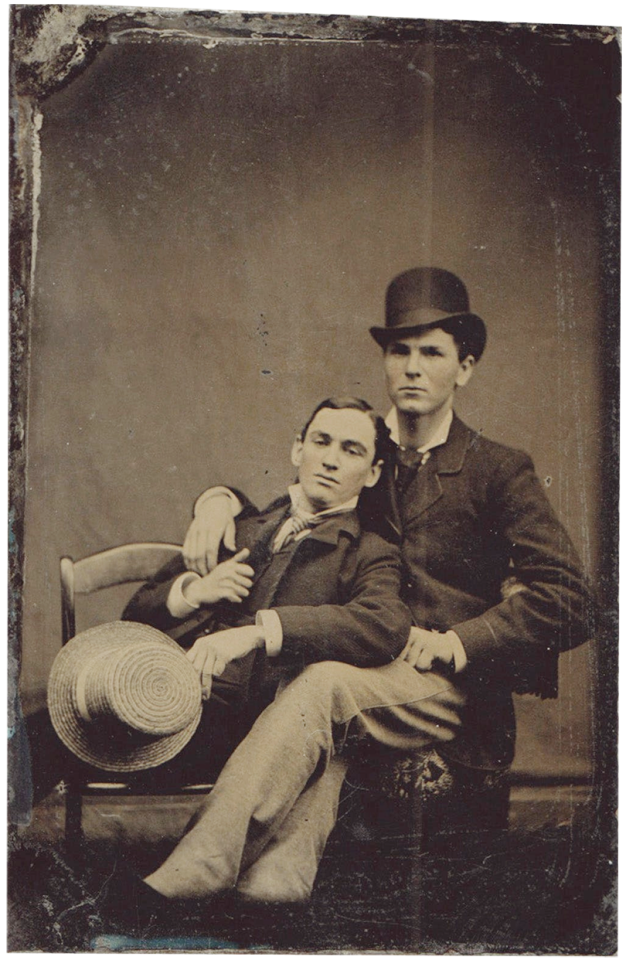
Tintype of a handsome pair, the man in front leaning cozily back into his companion's embrace, c. 1875-1880
#love the contrast between the rather reserved expressions and the very relaxed and even playful body language#interestingly this guy seems to be missing a portion of his left pinky finger#brightened for tumblr—refer solely to seller's pic if buying#19th century#1800s#1870s#19th century fashion#1870s fashion#men's fashion#menswear#fashion history#historical fashion#historical dress#19th century photography#tintype#ferrotype#19th century men#vintage men#gay interest
784 notes
·
View notes
Text
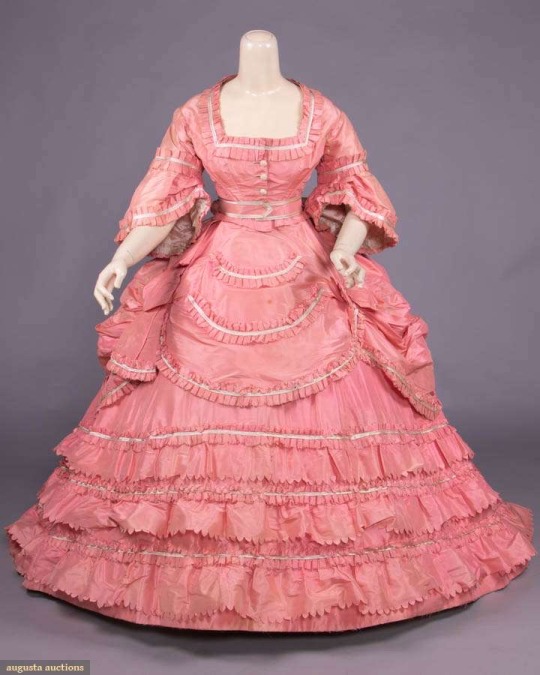
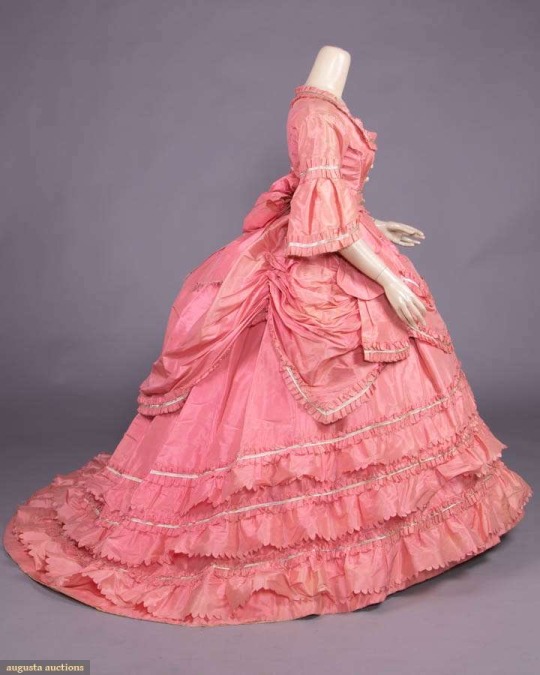
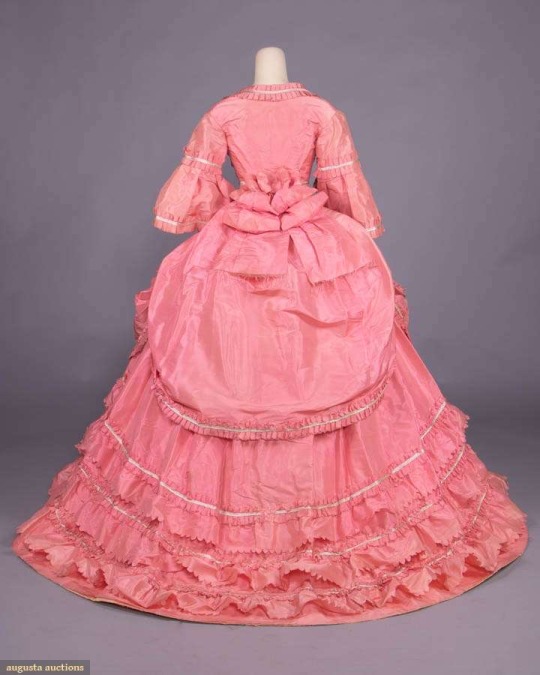
Pink Taffeta Ballgown, ca. 1872.
Augusta Auctions.
#pink#taffeta#womenswear#extant garments#dress#silk#ballgown#19th century#1872#1870s#1870s dress#1870s ballgown#1870s evening#augusta auctions#1870s extant garment
414 notes
·
View notes
Photo

Day Dress
Charles Frederick Worth
c.1870
Museum of Fine Arts, Boston (Accession Number: 2002.696.1-5)
#day dress#fashion history#historical fashion#charles frederick worth#1870s#house of worth#bustle era#1870#19th century#purple#off white#silk#lace#france#belle epoque#second empire#second french empire#mfa boston#gimme pictures of the evening bodice MFA boston
426 notes
·
View notes
Text

La Mode illustrée, no. 4, 28 janvier 1872, Paris. Toilettes de Mme Bréant-Castel, 28 rue Neuve des Petits Champs. Collection of the Rijksmuseum, Netherlands
Robe de dessous en satin blanc. Première jupe en tarlatane blanche, avec volant plissé ayant 25 centimètres de hauteur. Au-dessus de ce volant une bordure grecque en velours rouge, se terminant par des bouclettes de même velours. Seconde jupe pareille garnie de même (volant de moitié moins haut que le précédent), relevée de chaque côté. Corsage décolleté en velours rouge à petites basques et manches courtes. Collier en corail rouge. Dans les cheveux diadème en grenades.
Jupon de faye fris bleu, garni d'un volant froncé ayant 35 centimètres de hauteur. Au-dessus de ce volant, des pattes en velours de même couleur, fixées par un grand bouton d'argent. Au-dessus des pattes, une ruche en faye. Tunique garnie de même. Corsage montant à basques, et manches à volant avec même garniture. Sous-manches larges en dentelle.
—
White satin underdress. First skirt in white tarlatan, with pleated flounce 25 centimeters high. Above this flounce a Greek border in red velvet, ending in loops of the same velvet. Second similar skirt trimmed in the same way (ruffle half as high as the previous one), raised on each side. Low-cut red velvet bodice with small peplums and short sleeves. Red coral necklace. Pomegranate tiara in her hair.
Blue Faye Fris petticoat, trimmed with a gathered flounce 35 centimeters high. Above this ruffle, velvet tabs of the same color, attached by a large silver button. Above the legs, a faye ruffle. Tunic trimmed in the same way. High peplum bodice and ruffled sleeves with the same trim. Wide lace undersleeves.
#La Mode illustrée#19th century#1870s#1872#on this day#January 28#periodical#fashion#fashion plate#color#description#rijksmuseum#dress#gown#bustle#evening#suit#Modèles de chez#Madame Bréant-Castel
97 notes
·
View notes
Text


How about a wrapped gown? I mean, truly, this looks like a Christmas present.
This gown was made by fashion house and official royal dressmaker, Madame Elise and is likely one of Princess Alexandra's. It dates from around 1870, and you can see that it still has the hallmarks of the 1860s--especially that bodice--but is a bit less full. The bell-shape, tiered look has a lot going on! The dress was lost, but rediscovered in the 20th century in a shop in London.
Madame Elise was a powerhouse in London during this 1860s-1880s, but her warehouse compound was certainly not the best place to live and work. Dressmakers were expected to work long hours (6am-11pm) and were put in cramped quarters with very little ventilation.
One of the workers wrote: “At night we retire to rest in a room divided into little cells, each just large enough to contain two beds. There are two of us in each bed. There is no ventilation; I could scarcely breathe in them when I first came from the country. The doctor who came this morning said they were not fit for dogs to sleep in.”
From Fashion Museum Bath.
#fashion history#threadtalk#costume#historical costuming#victorian fashion#silk dress#late victorian fashion#costume history#textiles#holiday dress#evening gown#1870s fashion#circa 1870
518 notes
·
View notes
Text
Les Mis 1.2.2
Following up from Pilf’s post, because clothing is the topic I have stuff to say about. [Also the rest of the action feels very natural follow ups from the previous 15 chapters: the people and house we met in 1.1.1-14 are about to encounter the guy having an awful day in 1.2.1, and this is Hugo’s set up for that.]
Caveat: my main research area is the mid-19th century (right around the time Hugo was finishing Les Mis, not the years it is set), and my working language is English. The US in 1860 is not France in 1815-1832, but I think some elements here do transfer over, or at least offer insight into how Hugo’s readers might have interpreted the text.
Main observations re: Baptistine Myriel’s clothing:
9 years is a very long time for a dress in active use. Washing and non-washing dresses will have different trajectories, but in contemporary non-fiction, making a silk dress last 7 years is a feat of clever planning and care. Five years is noteworthy. One to two years is more typical, and 3 months isn’t necessarily a frivolous waste (wearing a silk dress only once would be). Much like with the soup thing, the Myriel household is taking ‘practicing good economy’ to an extreme, almost absurd degree.
Also, the fact that Mlle Baptistine is still wearing her silk dress “in the style of 1806″ in 1815 is notably weird. Fiction and non-fiction sources of the 1850s/60s show economically-minded women remodeling their silks every season in order to keep up to date. Magazine articles give instructions for turning last year’s flounced skirts into gored ones, or adding puffed overskirts to update narrow gored skirts. Advice books recommend getting an extra yard or two of fabric so that you can update the sleeves of your dress when it’s taken apart for washing. Trousseaus should have some of the dresses left “unmade” (as lengths of fabrics) in case fashions change over the year. A missionary woman writing from not-yet-Seattle in the mid-1850s opines that the dresses she made for her wedding less than a year earlier are too “rusty” to be worn at home (in New York) but are sufficient for living in the woods.
So my impression of Baptistine is that she’s meant to be The Superlatively Economical gentlewoman, and also Not At All Vain About Clothes. She’s not spending her time or money on fashion, but the fact that she is still bothering to wear a silk gown for dinner is signalling that she’s still performing (her class’s) respectability. From this, and her letter about re-doing her room, I expect that her whole wardrobe and all the house’s domestic interiors are scrupulously clean and mended, but also old and likely inharmonious. The two women will do the work to live respectably, but will not spend any unnecessary money on their own comfort or aesthetics.
Hugo taking the trouble to describe Baptistine’s dress (”short waist, a narrow, sheath-like skirt, puffed sleeves, with flaps and buttons”) just reminds me of how much crinoline-era Victorians do not like the Neoclassical look. All of these specific elements are basically the opposite of early 1860s fashion--waists are worn just at/above the natural waist, skirts are about as wide as they can get, more fitted coat sleeves are replacing the wide-open sleeves of the late 1850s. It’s a bit different from how most modern folks seem to view the 1810s style (Austen! Romance! Bridgerton?): I’ll need to dig through my notes, but there’s at least one 1850/60s cartoon and one article I recall which amount to ‘yikes, the fashions of 50 years ago were awful’, and another article from the late 1860s which holds that the crinoline is a great improvement on the raised-waistline silhouette. I think we all prefer to ignore the weirdness of the c.1865-9 Second Empire style, but there were absolutely pairing high waistlines with fitted sleeves and trained skirts over elliptical or half-hoops (transitioning from the rounder cages of the late 1850s and early 1860s into the bustles of the early 1870s).
#Les Miserables#1.2.2#les mis letters#overthinking it#I have a long-running research project on just how long people expected clothing to last in the period 1855-1865#it's pretty fragmentary still#but the 1870s-1890s sources will give you exact timetables of what you should buy and when to maintain a ladylike wardrobe on a budget#most run a 3-year cycle in which you buy the highest quality fabric you can#remake your old best garments to be your next year's second-best#and rotate items seasonally#even so you're looking at a quality winter coat is used three years as the longest-lived garment#bonnets get retrimmed for each season and put away when the weather turns#dresses do one or two seasons before you put them away then get refreshed when they're agian in season and discarded or remade after that
47 notes
·
View notes
Text
Berthe Morisot, Young Woman in an Evening Dress, 1879

3 notes
·
View notes
Text
Evening Dress


Title: Evening dress
Department Store: M.E. Curran & M.E. Clancy
Date: ca. 1873
Culture: American
Medium: silk
The Met Museum
#19th century fashion#19th century#historical fashion#bustle era#bustle#bustle era fashion#1870s fashion#1870s#fashion history#victorian dress#victorian era#evening dress
5 notes
·
View notes
Photo

Got way too excited about this 1873 French fashion plate shared by @chic-a-gigot, immediately thinking “oh I would wear that” so I slapped some colour on it to show what kinda fabric I’d make it up in, and then bc I was being self-indulgent as hell anyway I coloured the model to look like me and even warped her cheek line a bit bc it ain’t me without my chipmunk cheeks lol.
#pd alice draws#(…ish)#what the hell do I even tag this#uh#I mean it can still have the tags I’d put on the plate itself so#pretty dresses#victorian#1870s#and then I guess I’ll also pop it in my#literal gpoy#tag#bc that has some picrews and such in it too so I guess this counts#yes I am doing my hw I have required listening to do for my history of electronic music class#and paying attention to music takes a different part of my brain from doodling
34 notes
·
View notes
Note
Hi can you please elaborate on the Victwardian costume jewelry industry in Providence, RI that you mentioned? I am curious
Also, if you have any sources for further reading that would be appreciated. Thanks!
I'm just starting to learn about it myself!
Apparently, Providence was a center of costume jewelry production in the U.S. (that is, jewelry not made of actual precious metals and gems, or sometimes back then of gold with a low karat weight and semiprecious stones- AKA what most middle- and working-class people usually wear, then and now) from roughly the 1790s to the 1970s.
So it wasn't ONLY Victwardian and earlier, but that's the period that interests me the most. Because, just like many people seem to think working-class folks of the 19th century went around wearing shapeless rags, a lot of modern media seems to think that they never wore jewelry? I saw one criticism of Marmee's earrings in the 2019 Little Women movie because "why would a poor woman wear them?" It costs $0.00 to stab your earlobes with a needle, she's not doing a job where they might catch on things and hurt her, and all the gold-plated or rolled gold Victorian earrings I own would like a word with you.
(One of the few costuming choices in the movie that I don't despise with every fiber of my being.)
It feeds into my desire to explore the ways "ordinary" 19th-early 20th century people found to bring beauty into their lives. And I'm excited to learn more about it.
#ask#anon#fashion history#dress history#costume jewelry#I have a gold-filled bracelet from the late 1870s with a patent date on it that I traced to a specific jeweler in Providence#even found their old address though I've forgotten it now
61 notes
·
View notes
Photo

Bodice, 1875, Austria.
36 notes
·
View notes
Text

Peach silk evening dress, 1876-1878, British.
Victoria and Albert Museum.
#V&A#peach#womenswear#extant garments#dress#silk#19th century#1876#1870s#1870s extant garment#1870s britain#1870s dress#1870s evening#evening dress#evening#britain
86 notes
·
View notes
Photo
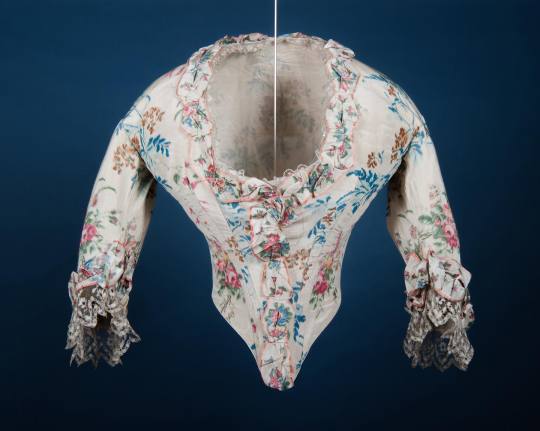
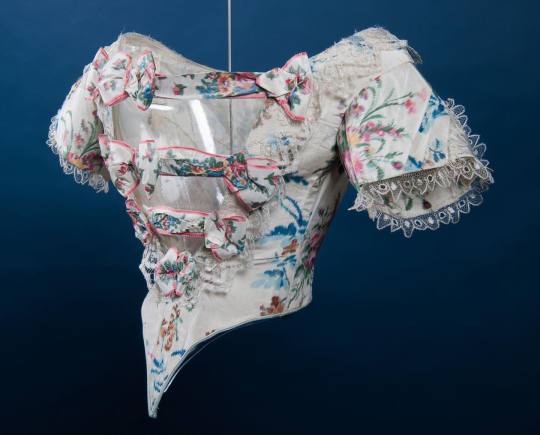
Day & Evening Bodices owned by Empress Eugenie of France
1850s-1870s
The Bowes Museum via Facebook
#evening dress#fashion history#empress eugenie#1850s#1860s#1870s#day dress#bodice#19th century#floral#flower print#silk#france#eugenie de montijo#french royal family#bowes museum
330 notes
·
View notes
Text

La Mode illustrée, no. 14, 3 avril 1870, Paris. Toilettes de Mme Bréant-Castel, 28, r. Nve des Pts Champs. Collection of the Rijksmuseum, Netherlands
Toilette de bal. Première jupe de tulle garnie de volants en tarlatane, plissés à la grecque. Le devant de la jupe à un seul volant; le lé de derrière est entièrement couvert de volants pareils. Au-dessus de ce volant se trouve une draperie fixée par des touffes de violettes, rattachées ensemble par des guirlandes de lierre. Tunique de satin vert clair, garnie d'un volant en blonde relevé par des bouquets de violette ceinture-pouff en même blonde. Dans les cheveux, branches de lierre et bouquets de violettes.
Jupe de dessous. En gaze de soie blanche à rayures mauve, garnie d'un volant pareil au-dessus duquel se trouve une bande de taffetas mauve, plissée, bordée de chaque côté d'une dentelle noire très-étroite. Tunique de taffetas mauve, garnie d'une même ruche et d'une dentelle noire ayant 10 centimètres de largeur; corsage ouvert en carré; manches larges. L'encolure est garnie, comme les manches, d'une bande plissée et d'une dentelle noire.
—
Ball gown. First tulle skirt trimmed with tarlatan ruffles, Greek pleated. The front of the skirt has a single ruffle; the back strip is entirely covered with similar ruffles. Above this ruffle is a drapery secured by tufts of violets, tied together by garlands of ivy. Light green satin tunic, trimmed with a blonde ruffle accented by bouquets of belt-pouff violet in the same blonde. In the hair, branches of ivy and bouquets of violets.
Underskirt. In white silk gauze with mauve stripes, trimmed with a similar ruffle above which is a strip of pleated mauve taffeta, bordered on each side with very narrow black lace. Purple taffeta tunic, trimmed with the same ruffle and black lace 10 centimeters wide; open square bodice; wide sleeves. The neckline is trimmed, like the sleeves, with a pleated band and black lace.
#La Mode illustrée#19th century#1870s#1870#on this day#April 3#periodical#fashion#fashion plate#color#description#rijksmuseum#dress#gown#ball#evening#bustle#Modèles de chez#Madame Bréant-Castel
30 notes
·
View notes
Text

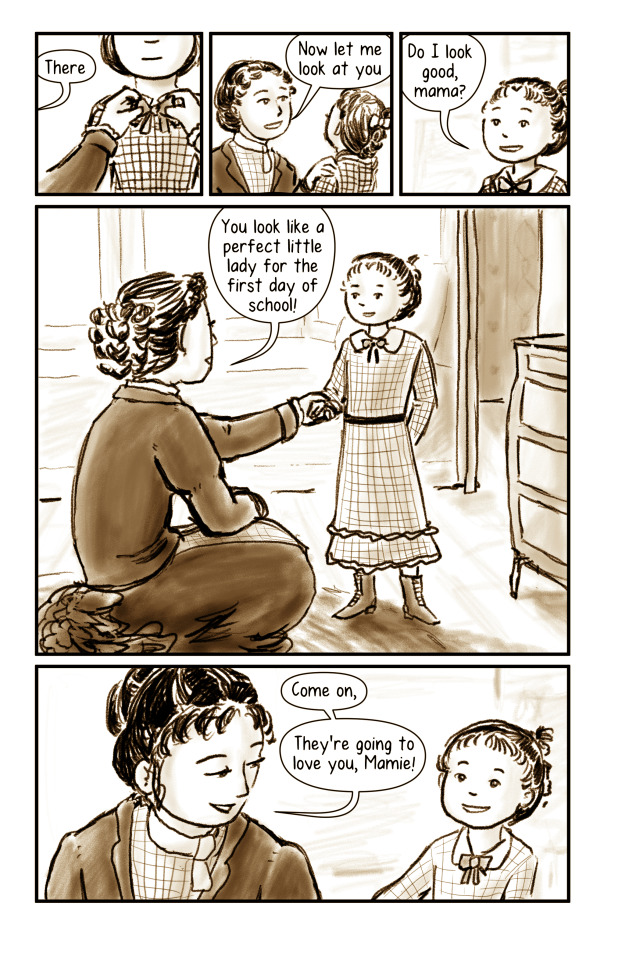
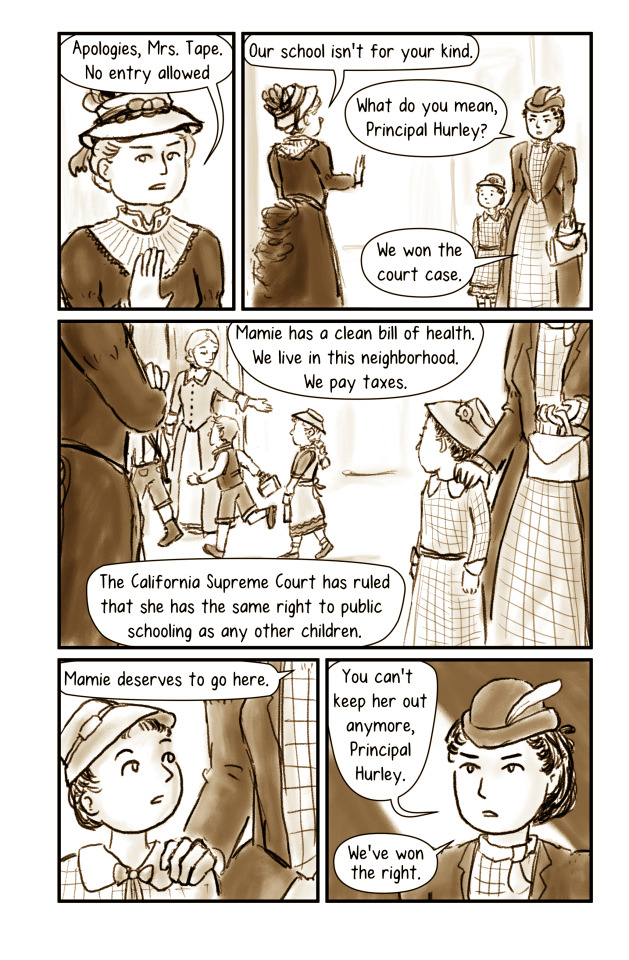
in my pursuit of ever-increasingly niche comics, I drew a 13 page comic about Tape v Hurley, a court case about Chinese-American school segregation in 1885. The rest of the pages are after the readmore, as well as on AO3 here. More obsure Chinese American court case comics are there, as well.

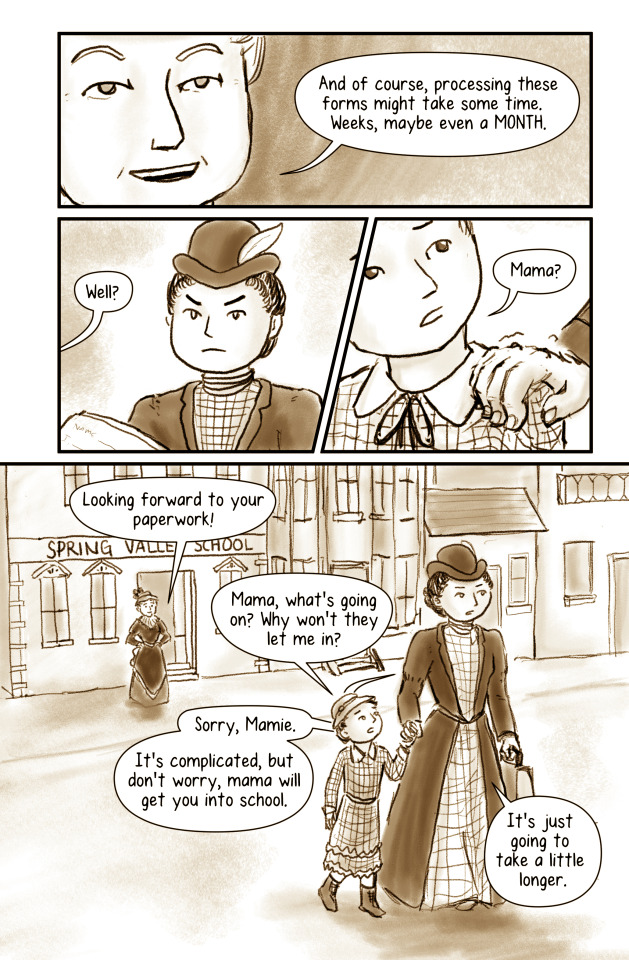
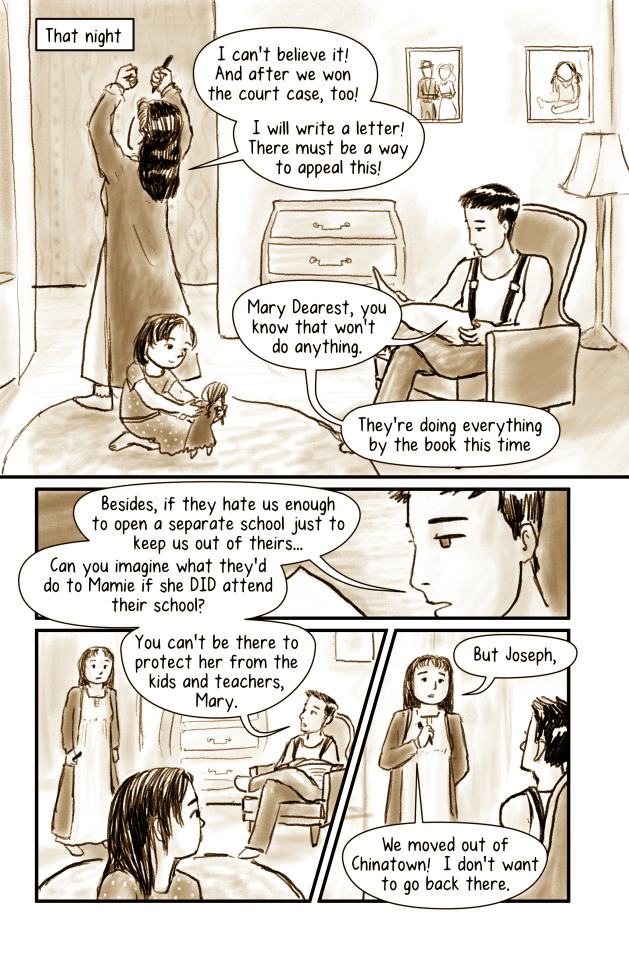
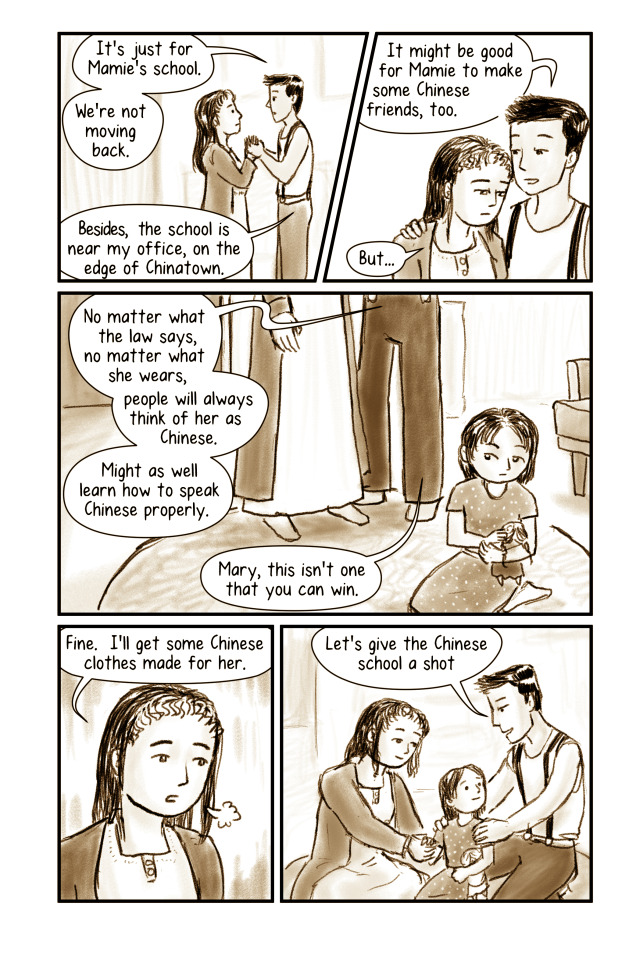
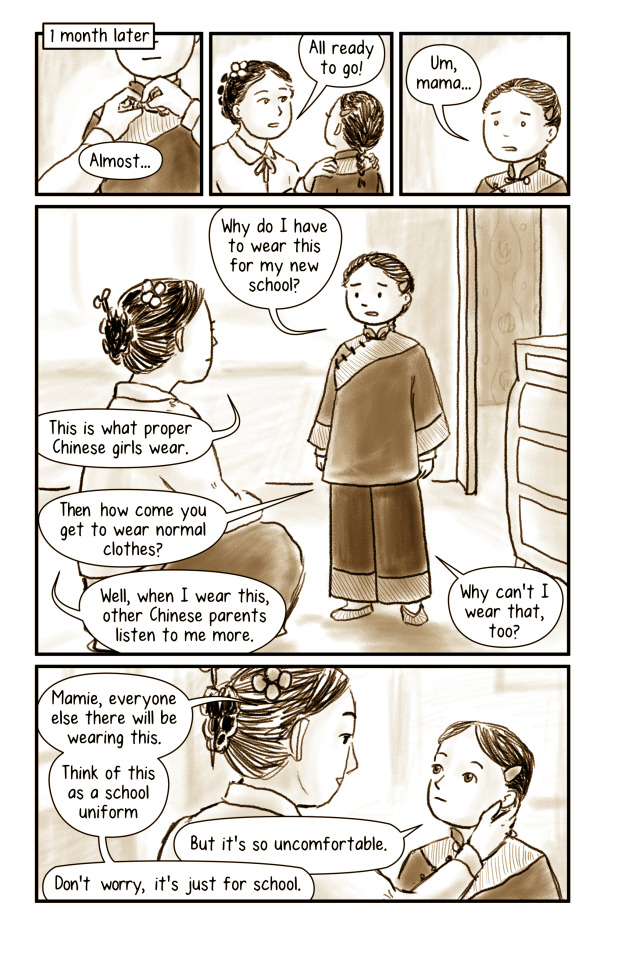
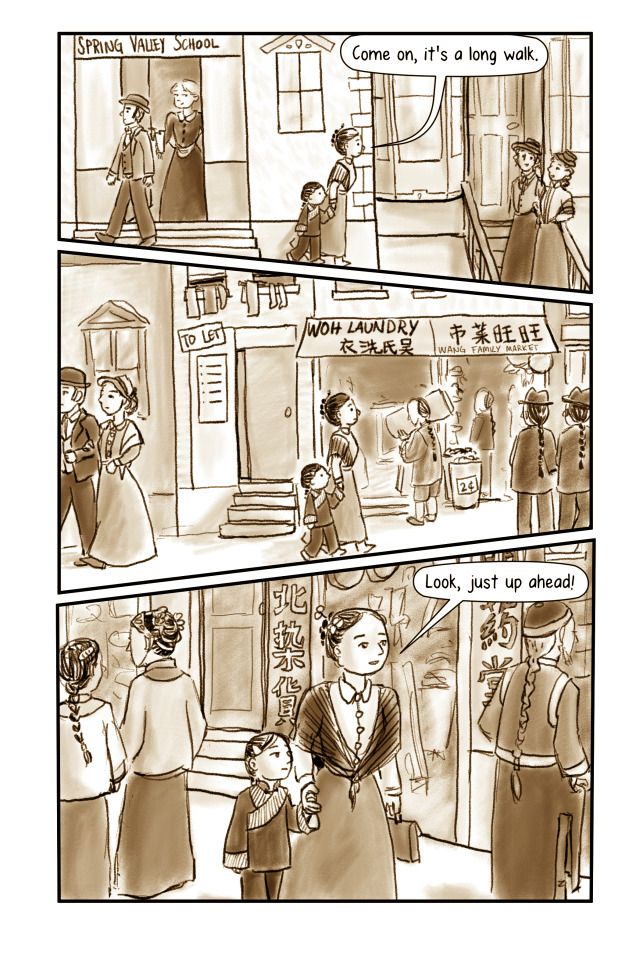
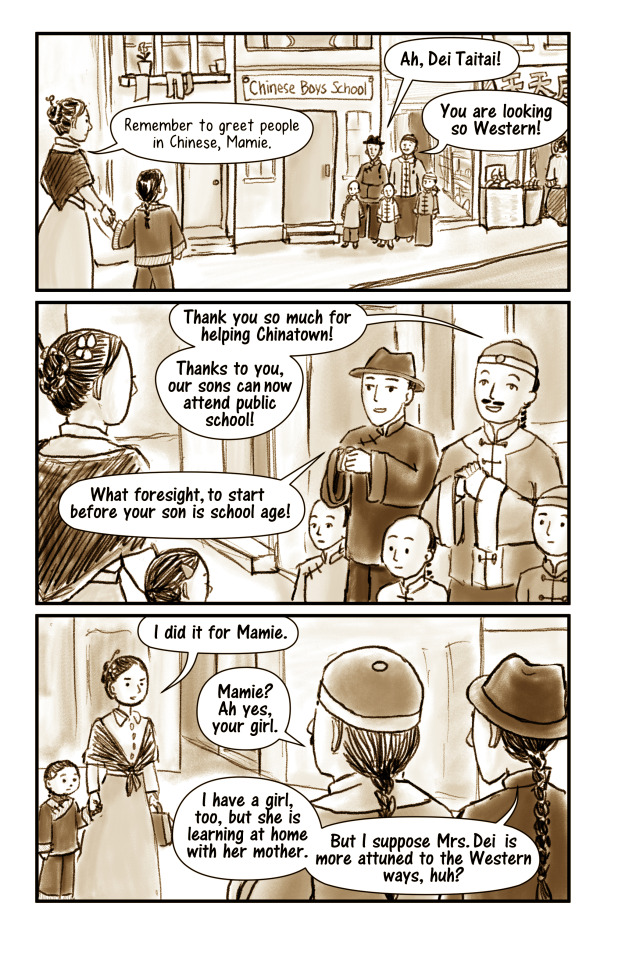
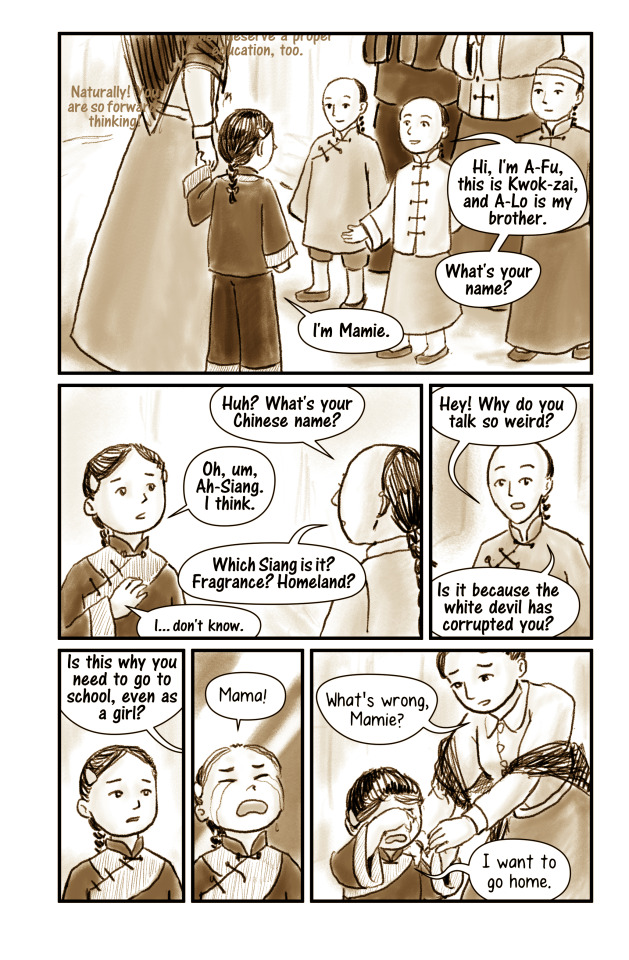
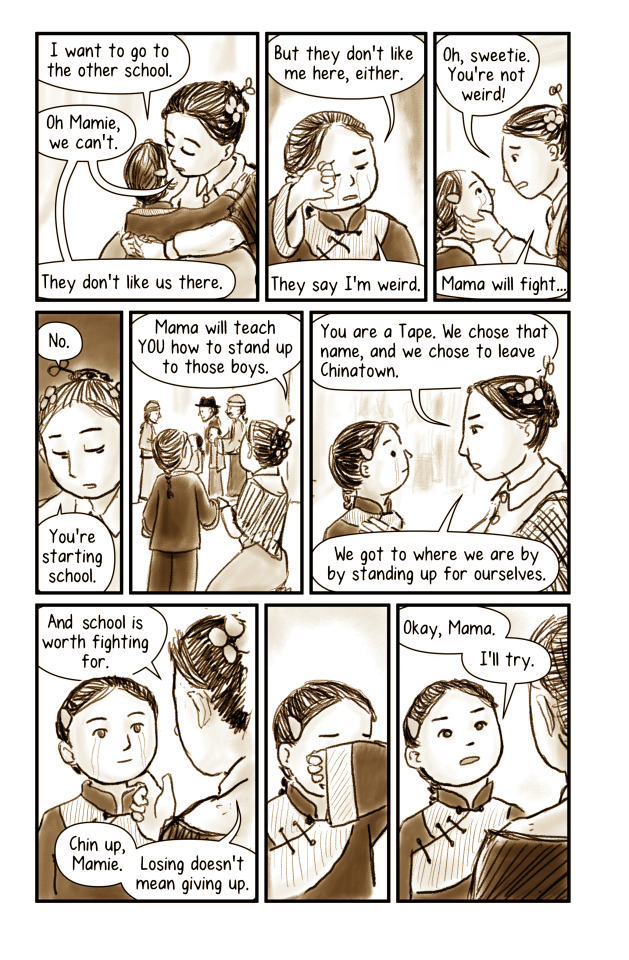
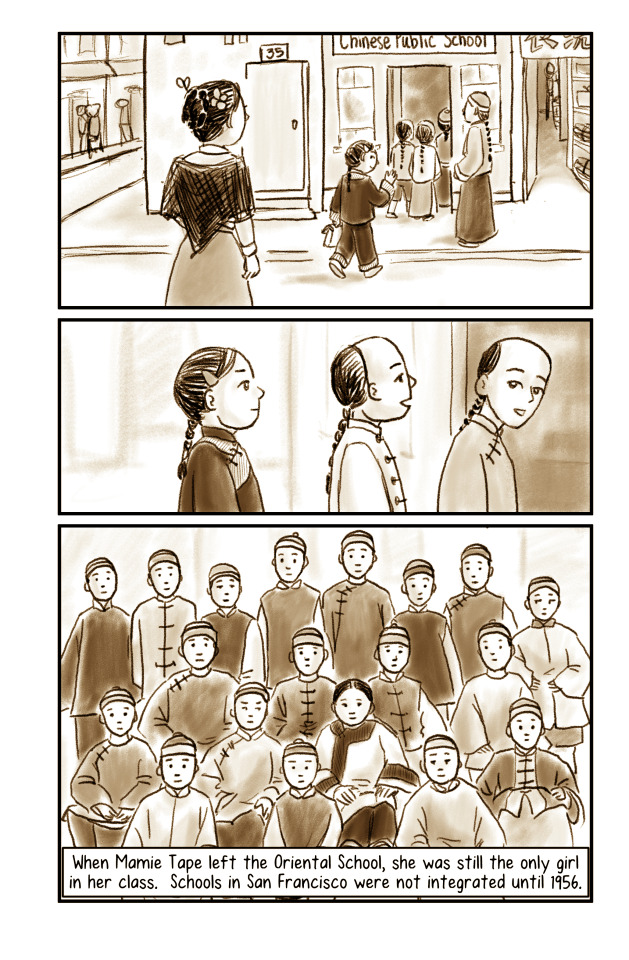
Historical Notes
Mary and Joseph Tape were not born in America, but their names and identities were very much formed in America. Joseph Tape was born Jeu Dip in Guangdong, China, immigrated the America when he was twelve, and spent his teenage years working as a house servant in an Irish household. Mary arrived in America at the age of eleven, and was found and raised as Mary McGladery in a Protestant orphanage as the only Chinese child amongst ~80 children. Both Mary and Jeu spent their formative years amongst White Christian families, so when Jeu Dip and Mary married in 1875, little wonder that Jeu picked the English name of Joseph Tape -- Joseph to match with Mary, and the German last name Tape as a nod to his former name of Dip.
The Tape family lived about 14 blocks outside of Chinatown, in a primarily white neighborhood. They dressed in Western clothing, spoke English at home, and Mamie grew up playing with non-Chinese kids. Naturally, they wanted their children to attend the local elementary school, a mere 3 blocks from their home. The principal, Ms. Hurley, denied her entrance, claiming that she was “filthy and diseased.” At the time, there was no public school option for Chinese children -- the 1870 state law stipulated separate schools for “African and Indian children” only, not Chinese. The Tape family, with the help of the Chinese Six Companies, their church, and the Chinese consulate, decided to sue, claiming that the 1880 California school code guaranteed everyone a right to public education and that this was a violation of the 14th Amendment.
They won.
But this was 1885, three years after the passage of the Chinese Exclusion Act and six years before Plessy v Ferguson. Regardless of what the California Supreme Court might decide, public sentiment was on the side of the San Francisco school district. Determined to keep out this “invasion of Mongol barbarism”, the California State Legislature passed a law permitting separate schools for Chinese children, which then allowed Principal Hurley to reject Mamie Tape once more.
While Mamie was rejected from the Spring Valley Elementary School for being Chinese, she also had a hard time fitting in to the Chinese public school. The Chinese merchants saw Western education as something primarily for boys. (Their girl children learned from their mothers at home.) Mamie, a girl dressed in Western clothes, would have stood out like a sore thumb. The final panel of the comic was based on a photo from three years later, and even then, Mamie was the only girl.
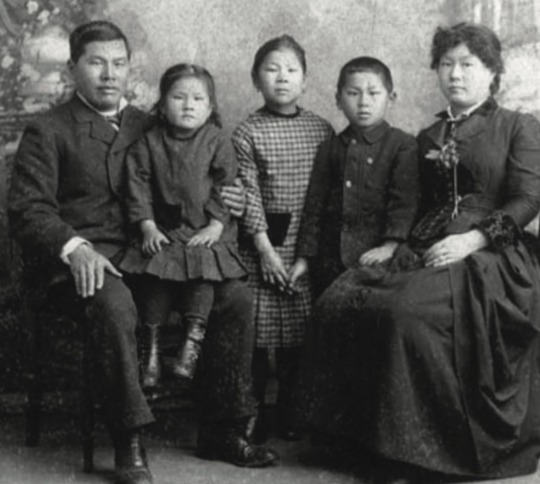
Places where I fudged the history: Frank, Mamie’s younger brother, was actually six years old and should have been more present in the comic, but I wante to keep the focus on Mamie and Mary. Also, Mamie had actually shown up to her first day of school in Western clothes. An earlier draft of the comic had a separate arc involving Mamie feeling rejected at school and Mary buying her some Chinese clothes, but that got too long and complicated.
Much of this was drawn from Mae Ngai’s book about the Tape family and their experiences as 2nd and 3rd generation Chinese Americans, titled “The Lucky Ones.”
----------
Here is Mary Tape's letter to the San Francisco School Board, 1885:
1769 Green Street.
San Francisco, April 8, 1885.
To the Board of Education -
Dear Sirs: I see that you are going to make all sorts of excuses to keep my child out off the Public schools. Dear sirs, Will you please to tell me! Is it a disgrace to be Born a Chinese? Didn’t God make us all!!! What right have you to bar my children out of the school because she is a chinese Decend. They is no other worldly reason that you could keep her out, except that. I suppose, you all goes to churches on Sundays! Do you call that a Christian act to compell my little children to go so far to a school that is made in purpose for them. My children don’t dress like the other Chinese. They look just as phunny amongst them as the Chinese dress in Chinese look amongst you Caucasians. Besides, if I had any wish to send them to a chinese school I could have sent them two years ago without going to all this trouble. You have expended a lot of the Public money foolishly, all because ofa one poor little Child. Her playmates is all Caucasians ever since she could toddle around. If she is good enough to play with them! Then is she not good enough to be in the same room and studie with them? You had better come and see for yourselves. See if the Tape’s is not same as other Caucasians, except in features. It seems no matter how a Chinese may live and dress so long as you know they Chinese. Then they are hated as one. There is not any right or justice for them.
You have seen my husband and child. You told him it wasn’t Mamie Tape you object to. If it were not Mamie Tape you object to, then why didn’t you let her attend the school nearest her home! Instead of first making one pre tense Then another pretense of some kind to keep her out? It seems to me Mr. Moulder has a grudge against this Eight-year-old Mamie Tape. I know they is no other child I mean Chinese child! care to go to your public Chinese school. May you Mr. Moulder, never be persecuted like the way you have persecuted little Mamie Tape. Mamie Tape will never attend any of the Chinese schools of your making! Never!!! I will let the world see sir What justice there is When it is govern by the Race prejudice men! Just because she is of the Chinese decend, not because she don’t dress like you because she does. Just because she is descended of Chinese parents I guess she is more of a American then a good many of you that is going to prewent her being Educated.
Mrs. M. Tape
#original comic#chinese american history#legal history#turns out there's a lot of chinese american court cases#that i have a lot of feelings about#my comic#mine
1K notes
·
View notes